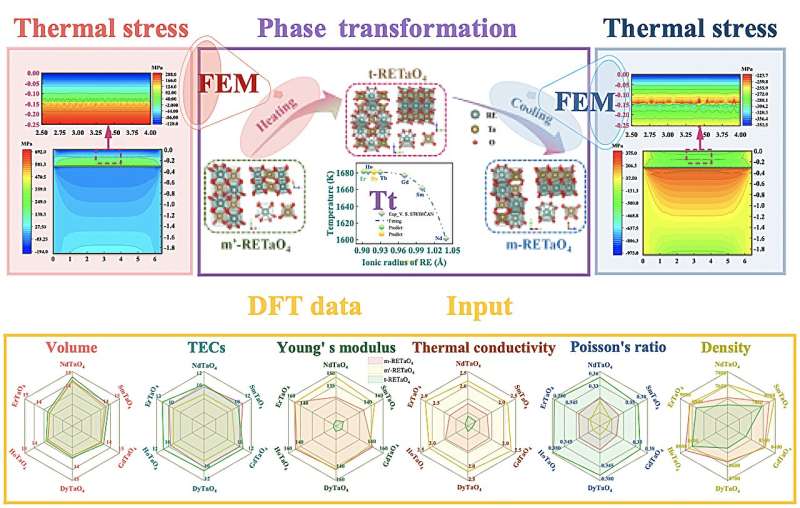
Thermal barrier coatings (TBCs) are widely used in gas turbine engines to obtain elevated working temperatures and improve engine efficiency. The phase transition of the ceramic layer is accompanied by a large volume difference, causing the concentration of thermal stress, eventually leading the TBCs to fall off and fail. Therefore, it is necessary to quantitatively evaluate the magnitude and distribution of thermal stress induced by phase transition in the ceramic layer.
A team of material scientists led by Prof. Xiaoyu Chong from Kunming University of Science and Technology in Kunming, China recently established a high-throughput multiscale evaluation method for thermal stress in TBCs that considers the phase transition of the top ceramic materials by coupling first-principles calculations with finite element simulations.
The method quantitatively evaluates and visualizes thermal stress of the real TBCs’ structure under thermal cycling by multifield coupling, which can provide an important theoretical basis and guidance for the life prediction and reverse design of coating materials.
The team has published their work in Journal of Advanced Ceramics.
“In this report, we develop a high-throughput multiscale evaluation method for thermal stress in multilayered systems, which considers the phase transition of the top ceramic materials by coupling first-principles calculations with finite element simulations. This approach can quantitatively evaluate and visualize the thermal stress in TBCs based on real structures, considering the actual service environment subjected to thermal cycling,” said Chong, a professor at the Faculty of Materials Science and Engineering at Kunming University of Science and Technology (China), whose research interests focus on the field of high-throughput multiscale computing and machine learning.
“The thermophysical properties’ input in finite element simulations are calculated by first-principles calculations, in which the multiscale method can consider the influence of phase transition and temperature and simultaneously reduce the cost and time of obtaining thermophysical properties by experiments,” he continued.
It is challenging to directly observe the phase transformation process of ceramic coating. As one of the main reasons for coating failure, thermal stress is subject to a lack of quantitative testing and characterization methods, and the high temperature service environment also increases the difficulty of phase transformation thermal stress testing.
“The finite element simulations coupled with multiple physical fields can visualize and quantitatively evaluate thermal stress of TBCs. However, the thermophysical properties required for finite element simulations are derived from experimental measurements, which ignores the effects of phase transition and temperature,” said Mengdi Gan, the first author of the paper and a Ph.D. student supervised by Prof. Chong.
In the study, the researchers develop a high-throughput multiscale evaluation method for thermal stress in multilayered systems, which considers the phase transition of the top ceramic materials by coupling first-principles calculations with finite element simulations.
This approach can quantitatively evaluate and visualize the thermal stress in TBCs based on real structures, considering the actual service environment subjected to thermal cycling. The thermophysical properties input in finite element simulations are calculated by first-principles calculations, in which the multiscale method can consider the influence of phase transition and temperature and simultaneously reduce the cost and time of obtaining thermophysical properties by experiments.
In this work, rare earth tantalites (RETaO4) are introduced as ceramic layers, and the results demonstrate that thermal stress undergoes a rapid escalation near the phase transition temperature, particularly in the TBCs_GdTaO4 system. This discontinuity in thermal stress may originate from the large alterations in Young’s modulus and thermal conductivity near the phase transition temperature.
The TBCs_NdTaO4 and TBCs_SmTaO4 systems exhibit noteworthy temperature drop gradients and minimal thermal stress fluctuations, which are beneficial for extending the service lifetime of the TBCs. This approach facilitates the prediction of failure mechanisms and provides theoretical guidance for the reverse design of TBCs materials to obtain low thermal stress systems.
Other contributors include Mengdi Gan, Tianlong Lu, Wei Yu, Jing Feng from the Faculty of Materials Science and Engineering at Kunming University of Science and Technology in Kunming, China.
More information:
Mengdi Gan et al, Capturing and visualizing the phase transition mediated thermal stress of thermal barrier coating materials via a cross-scale integrated computational approach, Journal of Advanced Ceramics (2024). DOI: 10.26599/JAC.2024.9220864
Provided by
Tsinghua University Press
Citation:
Researchers establish a high-throughput multiscale evaluation method for thermal stress in thermal barrier coatings (2024, April 25)
retrieved 25 April 2024
from https://phys.org/news/2024-04-high-throughput-multiscale-method-thermal.html
This document is subject to copyright. Apart from any fair dealing for the purpose of private study or research, no
part may be reproduced without the written permission. The content is provided for information purposes only.
